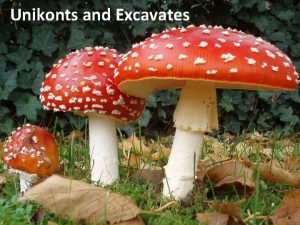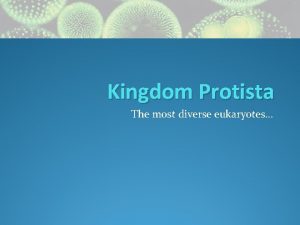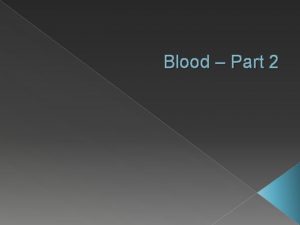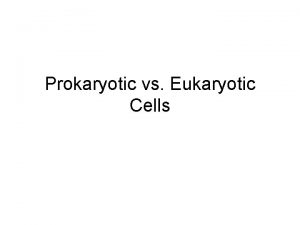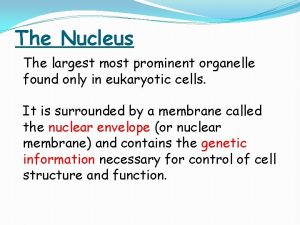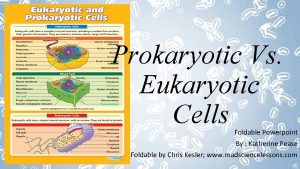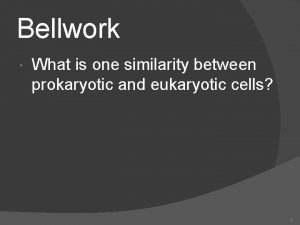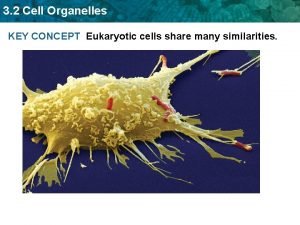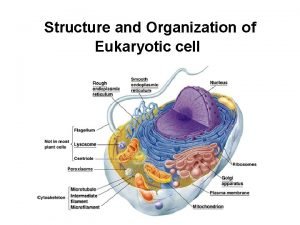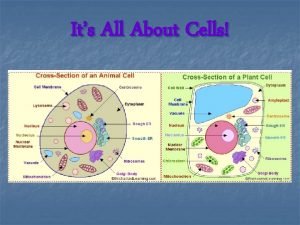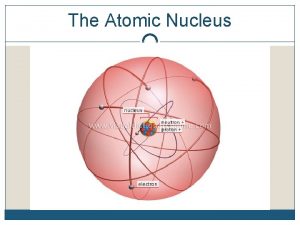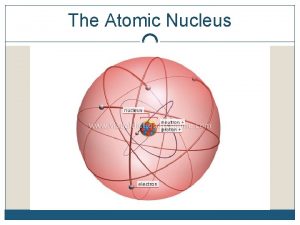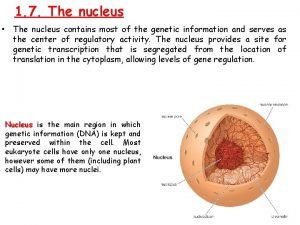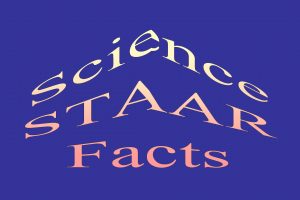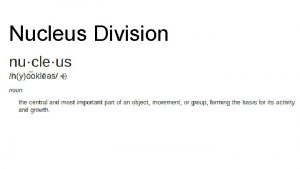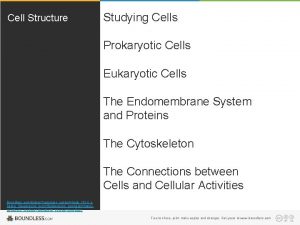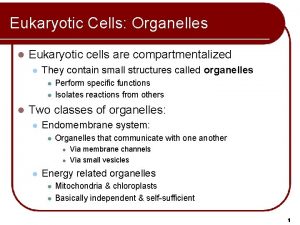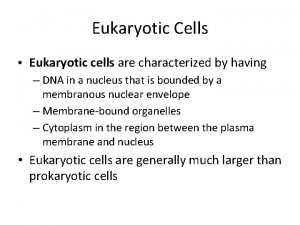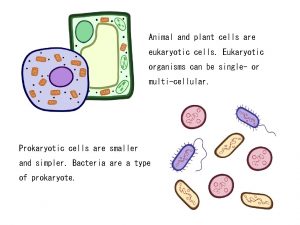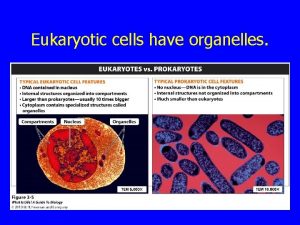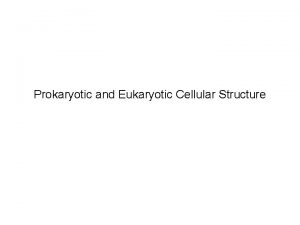Eukaryotic cells Structure of Eukaryotic cells Nucleus contains


















- Slides: 18

Eukaryotic cells

Structure of Eukaryotic cells • • Nucleus - contains DNA Membrane bound organelles – p 64 Larger than prokaryotic cells Divided into 5 categories: – Nucleus and ribosomes – Organelles of the endomembrane system – Peroxisomes and vacuoles – Energy related organelles – cytoskeleton

Nucleus • • Nucleus contain chromatin material Nucleoplasm – semifluid matrix RNA produced in nucleus Nucleolus – dark region of chromatin, r. RNA produced and forms ribosomes • Nuclear envelope – double membrane with nuclear pores (allow m. RNA and ribosomes out)

Ribosomes • • Non-membrane bound, protein synthesis Composed of 2 subunits Polyribosomes – group of ribosomes Cytoplamsic ribosomes and ER ribosomes produce their own proteins

Endomembrane System • • • Nuclear envelope membranes of ER golgi apparatus vesicles Compartmentalizes the cell Page 72

Endoplasmic reticulum • Physical continuous with the nuclear envelope • Rough – studded with ribosomes – synthesizes proteins – Forms vesicles that transport large molecules usually to cell membrane or Golgi apparatus Smooth – continuous with rough, contain gland cells that synthesize lipids

Golgi Apparatus • Stack of curved, flattened sacs, face ER and cell memebrane • Receives vesicles from ER • Sorts and packages proteins and lipids, some are lysosomes, others exit through exocytosis.

Lysosomes • • Membrane vesicles produced by GA contain hydrolytic digestive enzymes Recycle cellular material. Tay-Sachs disease result of missing enzyme that digests a fatty substance that helps insultate nerve cells. • Apoptosis – programmed cell death

Peroxisomes • Vesicles that enclose enzymes whose action results in hydrogen peroxide • Hydrogen peroxide is broken down to water and oxygen by catalase.

Vacuoles • Membranous sacs larger than vesicles • Usually store substances • Central vacuole – filled with cell sap that give support to cell and stores nutrients and waste products, plants do not have an excretory system. – Functions as lysosomes in plants, old organelles fuse with vacuole and get broken down.

Chloroplasts • Use solar energy to synthesize carbohydrates • A type of plastid (double membrane organelle that contains a series of internal membranes/vesicles and DNA) ex. Chromoplasts, leucoplasts. • Stroma (space), Thylakoid (disk), granum (stack of disks)

Mitochondria • Double membrane, outer and inner (cristae) • Cristae are folded to increase surface area • Matrix contains mt. DNA and ribosomes • Produce ATP

Cytoskeleton • Maintains shape of cell and allows organelles to move. • Contains actin filaments, intermediate filaments and microtubules.

Actin filaments • Long, thin flexible fibers • Structural role, just under cell membrane • Together with myosin, move the cell and its organelles.

Intermediate filaments • Ropelike assembly of fibrous polypeptides. • Roles include supporting nuclear envelope, plasma membrane and/or cell to cell junctions.

Microtubules • Small, hollow cylinders • Made of tubulin, small globular protein • During cell division, disassemble and reassemble as spindle fibers, and back again.

Centrioles • 9 + 0 microtubule triplets • In animal cells, contained in the centrosome - main microtubule organizing center for the cell • Involved in the process of microtubule assembly and disassembly? • In cell division, aid in mitotic spindle organization? • Give rise to basal bodies in cells with cilia and flagella?

Cilia and Flagella • Hair-like projections used for locomotion • Membrane bound, 9+2 pattern • Basal body in cytoplasm at base
 Prokaryotic v. eukaryotic cells
Prokaryotic v. eukaryotic cells Prokaryotic cell
Prokaryotic cell Prokaryotic cells vs eukaryotic cells
Prokaryotic cells vs eukaryotic cells Staphylococcus aureus prokaryotic or eukaryotic
Staphylococcus aureus prokaryotic or eukaryotic Discicristates
Discicristates Pyrrophyta
Pyrrophyta Lobed nucleus white blood cells
Lobed nucleus white blood cells Brick red blood
Brick red blood Nnn
Nnn A single celled organism that lacks a nucleus
A single celled organism that lacks a nucleus Most prominent organelle in eukaryotic cells
Most prominent organelle in eukaryotic cells Eukaryotic cells
Eukaryotic cells Three parts of cell theory
Three parts of cell theory Diff between prokaryotes and eukaryotes
Diff between prokaryotes and eukaryotes Similarity between prokaryotic and eukaryotic cells
Similarity between prokaryotic and eukaryotic cells Organelles in eukaryotic cells worksheet
Organelles in eukaryotic cells worksheet Eukaryotic cells
Eukaryotic cells Nonliving cells
Nonliving cells Definetion of cell
Definetion of cell




